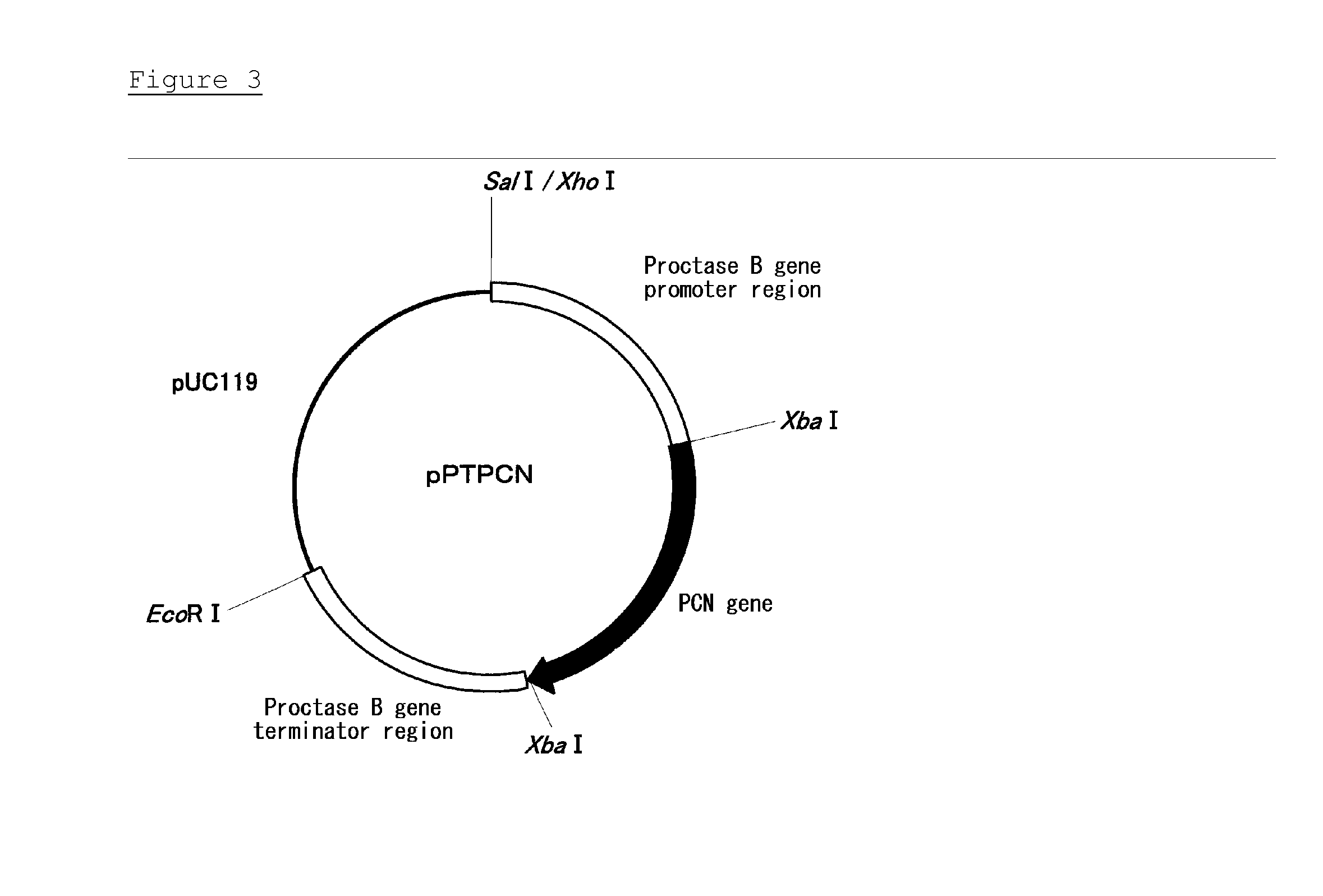Thermostable catalase
- Summary
- Abstract
- Description
- Claims
- Application Information
AI Technical Summary
Benefits of technology
Problems solved by technology
Method used
Image
Examples
example 1
Measurement of Catalase Activity (Thermostability) in Culture Liquid of Penicillium Pinophilum
[0113]Penicillium pinophilum grown on potato dextrose agar was inoculated in a 200 mL conical flask containing 30 mL of a medium (50 g / L sucrose, 20 g / L malt extract, and 5 g / L yeast extract), and cultivated at 26° C. for 5 days with shaking. The cells were removed from the resulting culture liquid by centrifugation to obtain the culture supernatant. The catalase activity (thermostability) of catalase contained in the resulting culture supernatant was measured by the method described in Example 4 of patent reference 6. The percentage of the remaining activity after incubating at 70° C. for 30 minutes was 50%. It was concluded from the result that Penicillium pinophilum produced thermostable catalase.
example 2
Isolation and Purification of Thermostable Catalase in Culture Liquid of Penicillium Pinophilum
[0114]Ammonium sulfate was dissolved in the culture supernatant of Penicillium pinophilum, obtained in the method described in Example 1, at a final concentration of 1 mol / L. The resulting solution was subjected and adsorbed to a hydrophobic column Phenyl Sepharose HP 26 / 10 (manufactured by GE Healthcare bioScience), which had been previously equilibrated with a 50 mmol / L phosphate buffer (pH7.0) containing 1 mol / L ammonium sulfate. Proteins adsorbed to the hydrophobic column were eluted and fractionated by a linear gradient elution method from a 50 mmol / L phosphate buffer (pH7.0) containing 1 mol / L ammonium sulfate to a 50 mmol / L phosphate buffer (pH7.0). A catalase activity of each fractionated eluate was measured by the method described in Example 1, and fractions having the activity were collected. Ammonium sulfate was added to the collected active fraction at a final concentration of...
example 3
Cloning of Thermostable Catalase Gene PCN from Penicillium Pinophilum
3-1) Preparation of Genomic DNA Library
[0115]Genomic DNA was isolated and purified from Penicillium pinophilum cells in accordance with the method of Horiuchi et al. [H. Horiuchi et al., J. Bacteriol., 170, 272-278, (1988)]. The isolated genomic DNA was partially digested with restriction enzyme Sau3AI. The resulting DNA fragments were ligated with BamHI arms of a phage vector EMBL3 cloning kit (manufactured by Stratagene) using a ligation kit Ver. 2 (manufacture by Takara Bio). The mixture was precipitated with ethanol and dissolved in a TE buffer. The whole amount of the ligated mixture and a MaxPlaxλ packerging kit (manufactured by Epicenter Technologies) were used to form phage particles, and an Escherichia coli XL1-blue MRA (P2) strain was infected with the phage particles. As a result, a genomic DNA library composed of 1.1×104 phages was obtained.
3-2) Preparation of Probe
[0116]The following primers ware prep...
PUM
| Property | Measurement | Unit |
|---|---|---|
| Fraction | aaaaa | aaaaa |
| Atomic weight | aaaaa | aaaaa |
| Volume | aaaaa | aaaaa |
Abstract
Description
Claims
Application Information
 Login to View More
Login to View More - R&D
- Intellectual Property
- Life Sciences
- Materials
- Tech Scout
- Unparalleled Data Quality
- Higher Quality Content
- 60% Fewer Hallucinations
Browse by: Latest US Patents, China's latest patents, Technical Efficacy Thesaurus, Application Domain, Technology Topic, Popular Technical Reports.
© 2025 PatSnap. All rights reserved.Legal|Privacy policy|Modern Slavery Act Transparency Statement|Sitemap|About US| Contact US: help@patsnap.com


